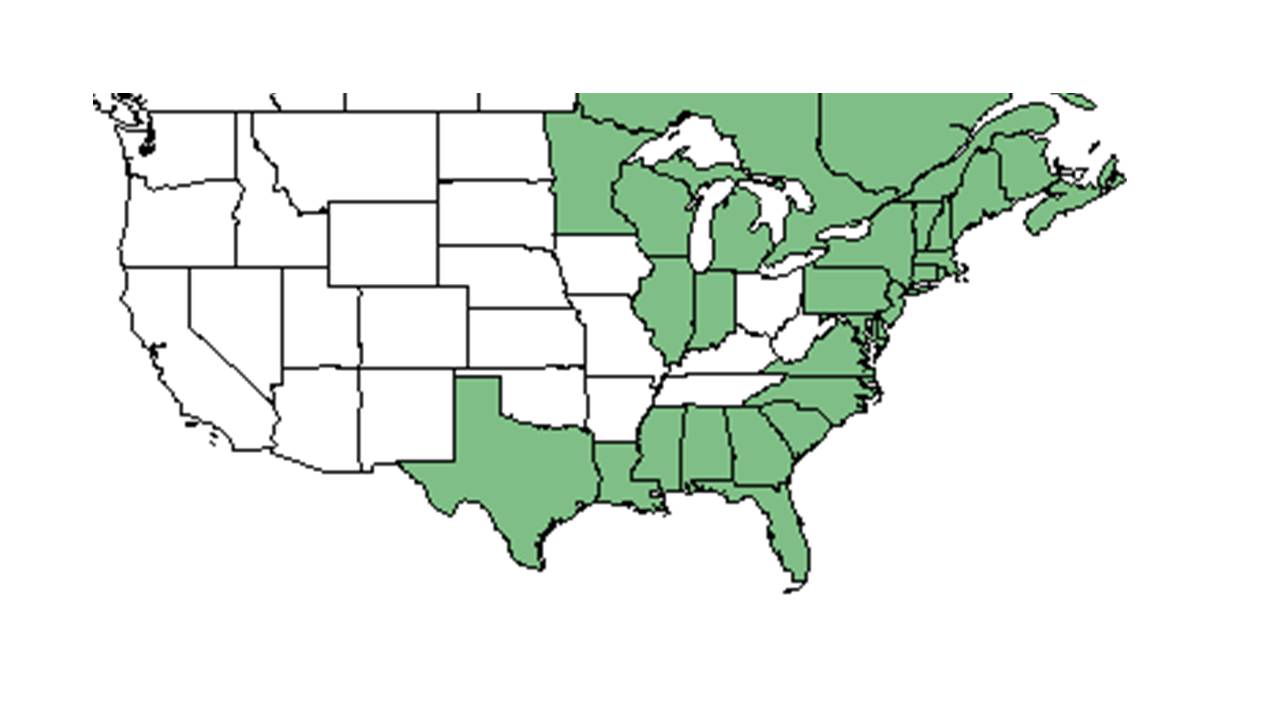Utricularia purpurea
| Utricularia purpurea | |
|---|---|

| |
| Photo was taken by Gil Nelson | |
| Scientific classification | |
| Kingdom: | Plantae |
| Division: | Magnoliophyta – Flowering plants |
| Class: | Magnoliopsida – Dicotyledons |
| Order: | Scrophulariales |
| Family: | Lentibulariaceae |
| Genus: | Utricularia |
| Species: | U. purpurea |
| Binomial name | |
| Utricularia purpurea Walter | |

| |
| Natural range of Utricularia purpurea from USDA NRCS Plants Database. | |
Common name: Purple bladderwort.[1]
Contents
Taxonomic notes
Synonym: Vesiculina purpurea (Walter) Rafinesque.[2]
Description
"Herbaceous aquatic or bog plants with bladders; stems submersed or subterranean, frequently capillary. Leaves alternate or whorled, rarely opposite, dissected or forked into filiform segments or linear when surficial. Scapes elongate, to 5 dm tall, 1-20 flowered; bract solitary at base of pedicel, bractlets paired with present, usually absent; pedicels 0.5-3 cm long. Calyx 2-lobed or lipped, upper lip entire or 2-lobed, lower lip usually 3-lobed, elevated inside as a palate and prolonged as a spur or sac. Capsules brown, globose; seeds usually numerous, brown or yellow."[3]
"Plant floating, branches whorled. Leaves whorled or opposite, segments frequently terminating in bladders. Scapes 5-9 cm tall, 1-3 flowered; bracts sessile, 1.5-3 mm long; pedicels spreading-ascending, 6-15 mm long. Calyx ca. 2.5 mm long, larger lobes ca. 2 mm long; corolla purple, 9-12 mm long, spur 3-5 mm long. Capsules 3-3.6 mm in diam.; seeds round, echinate or irregularly cristate, ca. 0.5 mm in diam."[3]
Distribution
Ecology
Habitat
Utricularia purpurea can be found entirely under water and frequent with Utricularia foliosa and Nymphaea.[4]
Phenology
This species has been observed to flower in April through November[5], and fruits in April through September.[4] carnivorous plant – bladderwort.[6]
Conservation, cultivation, and restoration
Cultural use
Photo Gallery
References and notes
- ↑ Weakley, A.S. 2015. Flora of the southern and mid-atlantic states. Working Draf of 21 May 2015. University of North Carolina at Chapel Hill, Chapel Hill, North Carolina.
- ↑ Weakley, A.S. 2015. Flora of the southern and mid-atlantic states. Working Draf of 21 May 2015. University of North Carolina at Chapel Hill, Chapel Hill, North Carolina.
- ↑ 3.0 3.1 Radford, Albert E., Harry E. Ahles, and C. Ritchie Bell. Manual of the Vascular Flora of the Carolinas. 1964, 1968. The University of North Carolina Press. 969. Print.
- ↑ 4.0 4.1 Florida State University Robert K. Godfrey Herbarium database. URL: http://herbarium.bio.fsu.edu. Last accessed: July 2015. Collectors: Robert K. Godfrey, Richard S. Mitchell, Annette Mitchell, Robert Kral, Loran C. Anderson, P. L. Redfearn, Jr., W. P. Adams, Grady W. Reinert, John B. Nelson, Kathy Craddock Burks, Elmer C. Prichard, M. R. Vodicka, Ted Bradley, J Stevenson, R. M. Schuster, Harry E. Ahles, J. Haesloop, D. B. Ward, S. S. Ward, Jean W. Wooten, D E Harrison, F Henry, Joel A. Barnes, Wilson Baker, Ann Johnson, N. Hotchkiss, Cecil R Slaughter, Palmer Kinser, Joe Beck. States and Counties: Florida: Bay, Calhoun, Collier, Franklin, Gulf, Hamilton, Highlands, Jefferson, Leon, Liberty, Orange, Osceola, Palm Beach, Santa Rosa, Taylor, Volusia, Wakulla, Walton. Georgia: Grady, Thomas, Ware. Michigan: Schoolcraft. Mississippi: Jackson. New Hampshire: Grafton. North Carolina: Brunswick. South Carolina: Orangeburg. Compiled by Tall Timbers Research Station and Land Conservancy.
- ↑ Nelson, G. PanFlora: Plant data for the eastern United States with emphasis on the Southeastern Coastal Plains, Florida, and the Florida Panhandle. www.gilnelson.com/PanFlora/ Accessed: 19 MAY 2021
- ↑ Hermann, S. M. (1995). Status and management of Florida's carnivorous plant communities. Tallahassee, Florida Game and Fresh Water Fish Commission, Nongame Wildlife Program.